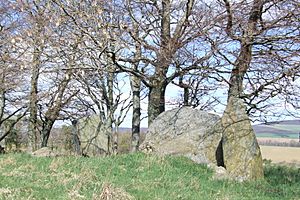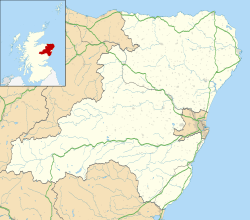Dunnideer stone circle facts for kids

Dunnideer in 2007
|
|
| Location | Scotland |
|---|---|
| Region | Aberdeenshire |
| Coordinates | 57°12′15″N 2°23′09″W / 57.2043°N 2.3859°W |
| OS grid reference | NJ609285 |
| Type | Recumbent stone circle |
| History | |
| Periods | Neolithic |
| Site notes | |
| Public access | Yes |
| Designated | 1925 |
| Identifiers | |
| Historic Environment Scotland | SM21 |
The Dunnideer stone circle is an ancient monument in Aberdeenshire, Scotland. It is near the town of Insch. Most of the original stone circle is now gone.
Only three stones are left today. They stand close to the old Dunnideer Castle. This site is a special protected place called a scheduled monument.
What are Recumbent Stone Circles?
Have you ever heard of a stone circle? A recumbent stone circle is a special kind of stone circle. People built them a very long time ago, during the early Bronze Age.
What makes them special? They always have one very large stone. This stone is called the 'recumbent' stone. It lies flat on the ground. It is usually placed towards the south or southwest part of the circle.
Two other tall stones stand next to the recumbent stone. These are called 'flanker' stones. They are often the tallest stones in the whole circle. The smallest stones are usually on the northeast side.
The rest of the circle would have had about six to ten more standing stones. These stones were usually different sizes. The builders often chose hillsides with great views for these circles.
Over 70 of these unique circles are found in northeast Scotland. Similar circles are also found in southwest Ireland. Recumbent stone circles often had a low mound of stones inside. This mound is called a ring cairn. Over many years, these mounds have often disappeared.
Scientists are not sure exactly why these circles were built. Some circles have shown signs of ancient burials.
History of Dunnideer Stone Circle
The Dunnideer stone circle was likely built during the Neolithic age. This was a very long time ago!
Sadly, many stones were removed from the circle in the 1800s. In 1578, a writer named John Lesley described the circle. He wrote that it was a "wonderful great crown of stones." He also said it would echo like brass or copper.
By the 1820s, only three or four stones were left. An artist named James Skene sketched the site then. By 1867, official surveys reported only three stones remained.
In 1902, a researcher named Frederick Coles visited the site. He confirmed there were three stones. He also noted they were covered in weeds. He saw other stone circles nearby too.
Some experts, like Aubrey Burl and Clive Ruggles, think there might have only ever been three stones. They wrote about this idea in 1985.
The Remaining Stones
The stones at Dunnideer are made of a rock called gabbro. The three stones still standing are the main recumbent stone and its two flankers.
The recumbent stone is standing upright now. It is about 2.8 meters (9.2 feet) long. It is 1.95 meters (6.4 feet) tall and 0.5 meters (1.6 feet) wide.
The two flanker stones have also been set upright again. The eastern flanker stone is about 2.25 meters (7.4 feet) tall. It is 1.0 meter (3.3 feet) wide and 0.85 meters (2.8 feet) thick.
The western flanker stone is about 2.0 meters (6.6 feet) long. It is 1.0 meter (3.3 feet) tall and 0.52 meters (1.7 feet) wide. This stone has a crack running down its side.
The Dunnideer stone circle became a protected monument in 1925.


